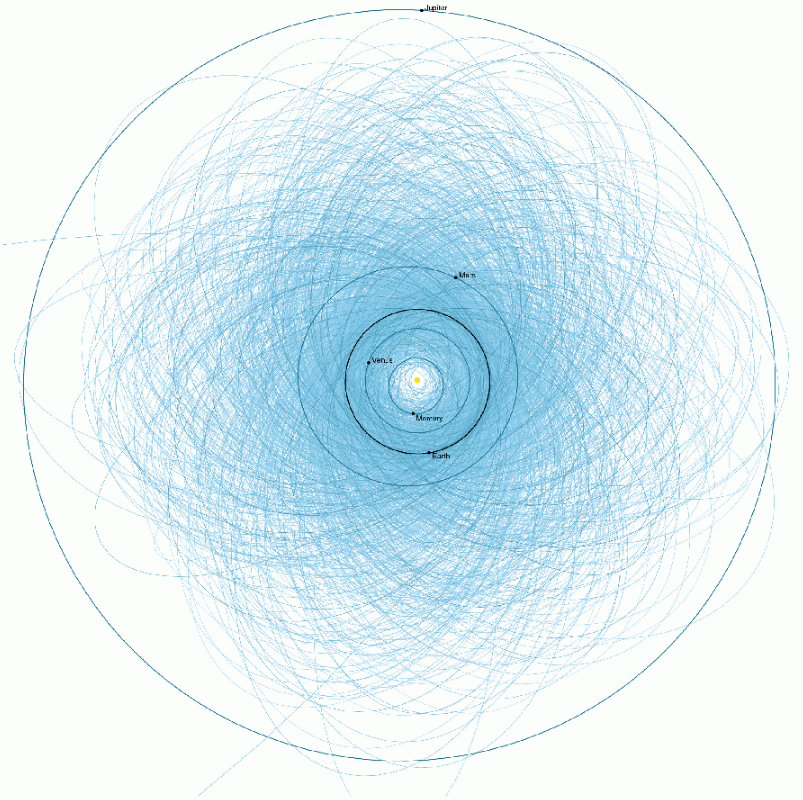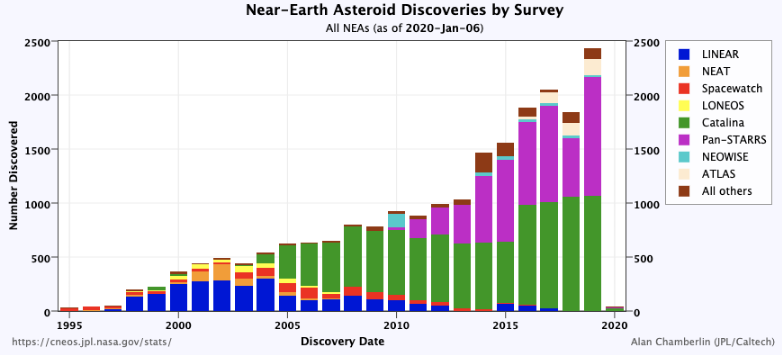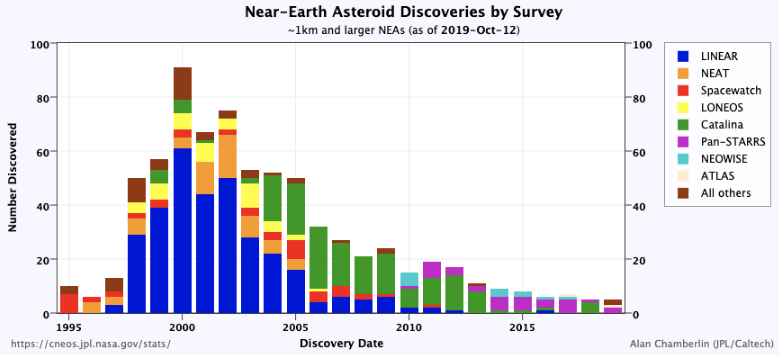
| Version | Summary | Created by | Modification | Content Size | Created at | Operation |
|---|---|---|---|---|---|---|
| 1 | Dean Liu | -- | 800 | 2022-11-11 01:37:21 |
Video Upload Options
The Near-Earth Object Surveillance Mission (NEOSM), formerly called Near-Earth Object Camera (NEOCam) is a planned space-based infrared telescope designed to survey the Solar System for potentially hazardous asteroids. The NEO Surveillance Mission will be carried out by the NEO Surveyor spacecraft, which will survey from the Sun–Earth L1 (inner) Lagrange point, allowing it to look close to the Sun and see objects inside Earth's orbit. The mission will be a successor to the NEOWISE mission; the principal investigator is also NEOWISE's principal investigator, Amy Mainzer at the University of Arizona. Since first proposed in 2006, the concept unsuccessfully competed repeatedly for NASA funding against science missions unrelated to planetary defense, despite a 2005 US Congressional directive to NASA. In 2019, it was decided to implement this mission by the Planetary Defense Coordination Office since it is a public safety issue. The Jet Propulsion Laboratory will lead development of the mission.
1. History
In 2005, the US Congress mandated NASA to achieve by the year 2020 specific levels of search completeness for discovering, cataloging, and characterizing dangerous asteroids larger than 140 meters (460 ft) (Act of 2005, H.R. 1022; 109th),[1][2] but it never appropriated specific funds for this effort.[3] NASA did not prioritize this mandate, and directed the NEOCam project to compete for funds against science missions unrelated to planetary defense or disaster mitigation planning.[4][5]
Proposals for NEOCam were submitted to NASA's Discovery Program in 2006, 2010, 2015, 2016 and 2017, but were never selected for launch.[5][6] The mission concept nonetheless received technology development funding in 2010 to design and test new infrared detectors optimized for asteroid and comet detection and sizing.[7][8] The project received additional funding for further technological development in September 2015 (US$3 million),[9][10][11] and in January 2017.[12]
Following calls to fully fund the mission outside NASA's Planetary Science Division or directly from Congress itself,[13][14] it was announced on 23 September 2019 that instead of competing for funding, NEOCam will be implemented under the name NEO Surveillance Mission with budget from NASA's Planetary Defense Coordination Office, within the Planetary Science Division.[15] The near-miss of asteroid 2019 OK, which slipped past extant detection methods in July 2019, has been suggested to have helped prompt this decision.[6][16][17]
For funding and management purposes, the NEO Surveillance Mission is officially a new project, but it is the same space telescope, the same team, and the mission's goals remain unchanged.[15][18]
2. Objectives
The main objective of the mission is to discover and characterize the orbit of most of the potentially hazardous asteroids larger than 140 meters (460 ft) over the course of its mission.[15][18] Its field of view will be large enough to allow the mission to discover tens of thousands of new NEOs with sizes as small as 30 m (98 ft) in diameter.[19] Secondary science goals include detection and characterization of approximately one million asteroids in the asteroid belt and thousands of comets, as well as identification of potential NEO targets for human and robotic exploration.[20][21]
The Jet Propulsion Laboratory (JPL) will lead development of the mission. The total cost of the mission is estimated to be between $500 million and $600 million.[15][18]
3. Spacecraft
The NEO Surveyor spacecraft will have a total mass of no more than 1,300 kg (2,900 lb), allowing it to launch on a vehicle like an Atlas 5 or Falcon 9 to the Sun–Earth L1 Lagrange point. The mission should reach the 90% congressional goal within 10 years, with an anticipated mission lifetime of 12 years.[22]
4. Telescope
Small asteroids are very difficult to see in the dark outer space with an optical telescope, but a telescope operating at infrared wavelengths is sensitive to asteroids whose surfaces have been warmed by the Sun.[23]
The NEO Surveillance Mission will employ a 50-centimeter (20 in) infrared telescope operating wide-field cameras at two thermal infrared wavelength channels for a total wavelength range between 4 µm and 10 µm.[2] Its field of view is 11.56 square degrees.[24] It will use a modified version of the HgCdTe Astronomical Wide Area Infrared Imager (HAWAII) mercury–cadmium–telluride detector developed by Teledyne Imaging Sensors.[25] The mission prototype detector was successfully tested in April 2013.[26][27] The detector array is 2,048 × 2,048 pixels and will produce 82 gigabits of data per day.[24] For good infrared performance without the use of cryogenic fluid refrigeration,[25] the detector will be passively cooled to 30 K (−243 °C; −406 °F) using techniques proven by the Spitzer Space Telescope.[24]
5. Operations
The NEO Surveyor spacecraft will operate in a halo orbit around the Sun–Earth L1 point, and employ a sunshade.[24] This orbit will allow fast data downlink speeds to Earth, allowing full-frame images to be downloaded from the telescope.[28]
6. Images



References
- H.R. 1022 (109th): George E. Brown, Jr. Near-Earth Object Survey Act - Original text. Tracking the United States Congress. Accessed: 31 October 2018. https://www.govtrack.us/congress/bills/109/hr1022/text/rh
- Finding Asteroids Before They Find Us. NEOCam Home site at NASA's Jet Propulsion Laboratory - Caltech. https://neocam.ipac.caltech.edu/
- 290 Asteroid News: Time Is Running Out. Kevin Anderton, Forbes. 31 October 2018. https://www.forbes.com/sites/kevinanderton/2018/10/31/asteroid-news-time-is-running-out-infographic/#2e65ae9c2d7c
- A space-based survey, not luck, must be our plan against hazardous asteroids. Richard P. Binzel, Donald K. Yeomans and Timothy D. Swindle. SpaceNews. 12 October 2018. https://spacenews.com/op-ed-a-space-based-survey-not-luck-must-be-our-plan-against-hazardous-asteroids/
- Mosher, Dave (13 January 2017). "City-killing asteroids will inevitably strike Earth — but NASA isn't launching this mission to hunt them down". Business Insider. http://www.businessinsider.com/neocam-mission-not-fully-funded-nasa-2017-1.
- This Summer's Asteroid Near-Miss Helped Greenlight NASA's NEOCam Mission to Search the Skies for Killer Spacerocks. Evan Gough, Universe Today. 25 September 2019. https://www.universetoday.com/143527/this-summers-asteroid-near-miss-helped-greenlight-nasas-neocam-mission-to-search-the-skies-for-killer-spacerocks/
- "NEOCam - Mission". NASA/Jet Propulsion Laboratory. https://neocam.ipac.caltech.edu/page/mission.
- "NASA Announces Three New Mission Candidates". Discovery News. NASA. 5 May 2011. http://discovery.nasa.gov/news/index.cfml?ID=1034.
- Clark, Stephen (7 September 2016). "NASA official says new mission selections on track despite InSight woes". Spaceflight Now. https://spaceflightnow.com/2016/09/07/nasa-official-says-new-mission-selections-on-track-despite-insight-woes/.
- Clark, Stephen (24 February 2014). "NASA receives proposals for new planetary science mission". Spaceflight Now. http://spaceflightnow.com/2015/02/24/nasa-receives-proposals-for-new-planetary-science-mission/.
- Kane, Van (2 December 2014). "Selecting the Next Creative Idea for Exploring the Solar System". The Planetary Society. http://www.planetary.org/blogs/guest-blogs/van-kane/20141201-selecting-the-next-creative-discovery-mission.html.
- Voosen, Paul (4 January 2017). "Updated: NASA taps missions to tiny metal world and Jupiter Trojans". Science. http://www.sciencemag.org/news/2017/01/updated-nasa-taps-missions-tiny-metal-world-and-jupiter-trojans.
- About 17,000 Big Near-Earth Asteroids Remain Undetected: How NASA Could Spot Them. Mike Wall, Space.com. 10 April 2018. https://www.space.com/40239-near-earth-asteroid-detection-space-telescope.html
- NASA won't launch a mission to hunt deadly asteroids. Tim Fernholz, Quartz. 5 July 2019. https://qz.com/1659566/nasa-nixes-hunt-for-deadly-asteroids/
- Foust, Jeff (23 September 2019). "NASA to develop mission to search for near-Earth asteroids". SpaceNews. https://spacenews.com/nasa-to-develop-mission-to-search-for-near-earth-asteroids/.
- NASA Announces New Mission To Search for Asteroids. Marcia Smith, Space Policy Online. 23 September 2019. https://spacepolicyonline.com/news/nasa-announces-new-mission-to-search-for-asteroids/
- NASA will develop a $600 million telescope to detect near-Earth objects. Chrissy Sexton, Earth.com. 27 September 2019. https://www.earth.com/news/nasa-telescope-near-earth-objects/
- NASA to build telescope for detecting asteroids that threaten Earth. Paul Voosen, Science Magazine. 23 September 2019. Quote: […] the mission is the same, says Mark Sykes, CEO of the Planetary Science Institute in Tucson, Arizona, and a member of NEOCam's science team. "There is no independent or new spacecraft or operational design here. This mission is NEOCam." https://www.sciencemag.org/news/2019/09/nasa-build-telescope-detecting-asteroids-threaten-earth
- "NEOCam - Instrument". NASA/Jet Propulsion Laboratory. http://neocam.ipac.caltech.edu/page/Instrument.
- "NEOCam - Science". NASA/Jet Propulsion Laboratory. http://neocam.ipac.caltech.edu/page/science.
- Mainzer, Amy K. (October 2016). "NEOCam: The Near-Earth Object Camera". 48th Meeting of the Division for Planetary Sciences. 16–21 October 2016. Pasadena, California.. Bibcode: 2016DPS....4832701M. http://adsabs.harvard.edu/abs/2016DPS....4832701M
- NEO Surveillance Mission. Gunter Dirk Krebs, Gunter's Space Page'. Accessed on 28 September 2019. https://space.skyrocket.de/doc_sdat/neo-surveilance-mission.htm
- NEOCam - Why Infrared? JPL - NASA. Accessed on 30 September 2019. https://neocam.ipac.caltech.edu/page/whyinfrared
- Mainzer, Amy K. (18 November 2009). "NEOCam: The Near-Earth Object Camera". 2nd Small Bodies Assessment Group Meeting. 18–19 November 2009. Boulder, Colorado.. https://www.lpi.usra.edu/sbag/meetings/sbag2/presentations/Mainzer_SBAG2009_NEOCam.pdf. Retrieved 13 January 2018.
- "Near Earth Object Camera (NEOCam)". Teledyne Scientific & Imaging. http://www.teledyne-si.com/learn-more-neocam.html.
- "NASA-Funded Asteroid Tracking Sensor Passes Key Test". NASA. 15 April 2015. https://www.nasa.gov/mission_pages/asteroids/news/neocam20130415.html.
- A monolithic 2k × 2k LWIR HgCdTe detector array for passively cooled space missions. Meghan Dorn; Craig McMurtry; Judith Pipher; William Forrest; Mario Cabrera; Andre Wong; A. K. Mainzer; Donald Lee; Jianmei Pan. Proceedings, Volume 10709, High Energy, Optical, and Infrared Detectors for Astronomy VIII; 1070907 (2018) doi:10.1117/12.2313521 https://www.spiedigitallibrary.org/conference-proceedings-of-spie/10709/1070907/A-monolithic-2k-x-2k-LWIR-HgCdTe-detector-array-for/10.1117/12.2313521.short?SSO=1
- Mainzer, A. et al. (May 2015). "Survey Simulations of a New Near-Earth Asteroid Detection System". The Astronomical Journal 149 (5): 17. doi:10.1088/0004-6256/149/5/172. Bibcode: 2015AJ....149..172M. https://dx.doi.org/10.1088%2F0004-6256%2F149%2F5%2F172




